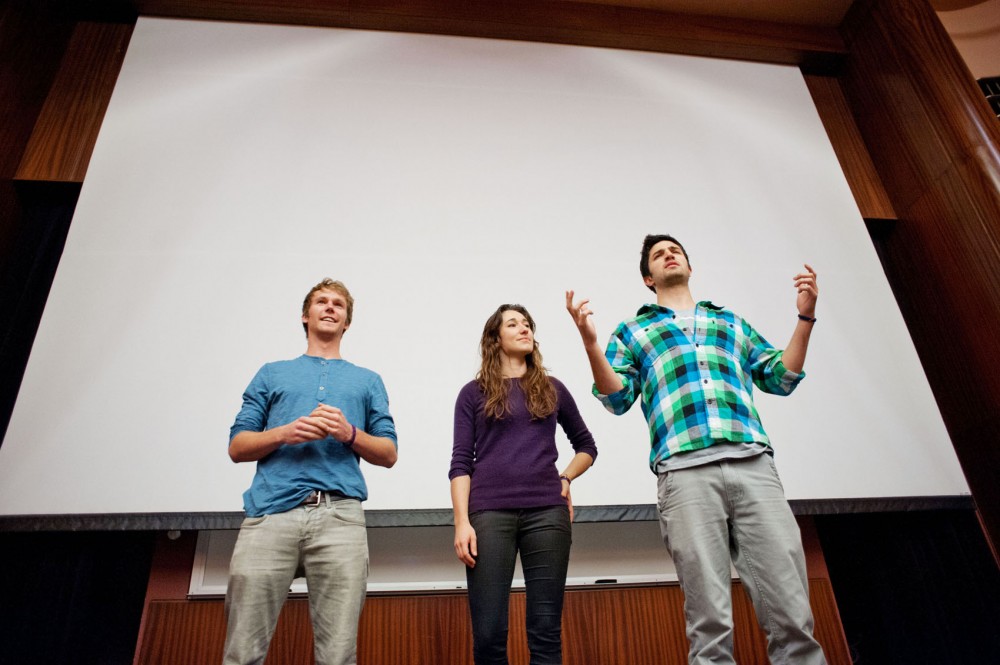As Zach Ingrasci watches footage of his body slowly emaciate — 18 pounds worth over a two-month trip to Guatemala — he is viscerally reminded of the summer he spent living on a dollar a day.
“I’d never actually been truly hungry before,” he said of the experience he shared with two friends the summer following his sophomore year of college.
For 56 days, the group lived in a shack in Peña Blanca, Guatemala with a budget of only a dollar each day to better understand extreme poverty.
Upon their return, the three friends founded Living on One, a nonprofit that evolved into a national tour and feature-length documentary, which was screened Sunday at the University of Minnesota’s Bell Museum of Natural History.
The University’s screening of the film was hosted by L.I.F.E. (Lending, Investing, Financing and Empowering), a student group that advocates the importance of microfinance. Living on One has reached out to similar student groups across the nation.
This, coupled with program director Hannah Gregg’s hometown ties to Minneapolis, encouraged Living on One to make the University a stop on its tour.
Luting Cheng, an officer for L.I.F.E., said she thought the event would be “a really nice eye-opener” for the campus community.
After the 50-minute screening and discussion with creators, Cheng said she was touched by the film and found the sacrifices made within Peña Blanca’s impoverished community inspiring.
Another L.I.F.E. member, marketing junior Thomas Sager, said he sees the documentary as a useful tool for club members to spread their message.
“Through our organization we talk about these things in a group setting,” he said “but we’ve never been able to visually see them and hear from people who experienced these things themselves.”
Living on a dollar a day
For the trio of undergraduates, the arrival to Peña Blanca was a “huge smack in the face.”
They said they were unprepared for the trip’s 800-calorie-a-day diet, battles with E. coli and surviving on their budget, which totaled $56 for the entire trip.
To simulate extreme poverty conditions, the group drew a number that would indicate how much they would get “paid” that day, ranging from nothing to $9. They said this made it much more difficult to budget their resources.
The group also wanted to underscore the importance of microfinance loans by taking out a small loan to grow radish seeds on a plot. By the end of their two-month stay, they were able to pay the loan back with interest.
After YouTube videos from the trip amassed more than 600,000 views, the students said they began getting calls from teachers who were using their videos in their lesson plans. Living on One then decided to share its experience further.
Chris Temple, the project’s co-executive director, said each “mini-success” — including YouTube popularity, a Ted Talk in Argentina and the members’ recent graduation — encouraged them to embark on the national tour.
The group kicked off its tour in Austin, Texas, this September in an old school bus borrowed from a friend.
Gregg said the connections they’ve made with various students and campuses along the way — including the University of Minnesota — have kept them motivated.
“To hear we have connected makes it worth it,” she said.
Putting a face on poverty
In their economic development courses at Claremont McKenna College in California, Ingrasci and Temple heard a recurring statistic: 1.4 billion people live on less than $1.25 a day.
But they said for them, like many college students, it was difficult to put a face on the figure.
“We knew that we would never be able to replicate poverty fully, but we could at least get a different understanding and approach this in a different way,” Ingrasci said.
Ultimately, they said they realized small changes can make a big impact in impoverished communities.
For example, Gregg said families in Guatemala who were able to budget $2 a day instead of one through microfinance loans found increased nourishment and opportunity.
Similarly, volunteers who donate a few dollars or hours of their time, Gregg said, can change a family’s entire world.
“Coming home was really difficult.” Ingrasci said. “This was a two-month experience for us, but they are still there struggling at that level.”


